
One of the crumbling main buildings in 1999, before everything was demolished

One of the crumbling main buildings in 1999, before everything was demolished
I really liked the way the evening light played off the crumbling bricks. At first, I just walked in the main driveway, Canbar road. There were no gates, and I could walk around the factory grounds. Some parts were still being demolished, but I did see some movement of people looking in one of the windows once.
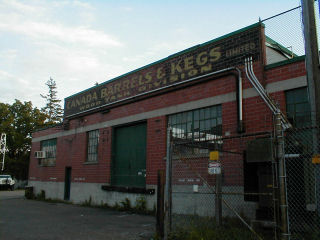 Canadian Barrels and Kegs building |
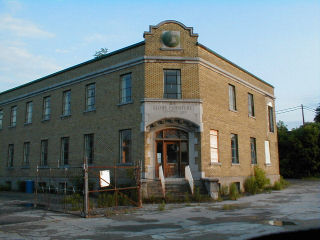 The old Globe Furniture building |
The name "Canbar" was some abbreviation of "Canadian Barrel and Keg". The company started its life just making barrels, mostly for the nearby Seagrams Distillery, I think. The distillery stopped operations in Waterloo in 1990. From there it got into all kinds of things, like making plastic tanks and playground equipment. There was always this plastic resin smell around the factory. Not a very good smell. The smell from the Seagrams Distillery was more agreeable. This building was the last one to come down, and I was hoping they would leave it standing. It had roof trusses made of nice, big 8"x8" timber.
The nice building in the right image is the old Globe Furniture company office. It looked in pretty good shape, but it too got demolished. I later read that they let artists use this building for studios for a while before it was torn down. After they tore the walls off it, I could see that the inside of the building was somewhat unremarkable - not as nice as the outside would suggest.
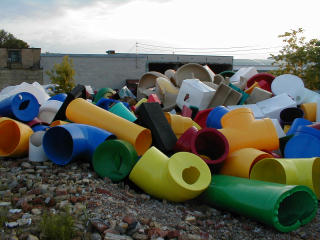 Plastic playground parts |
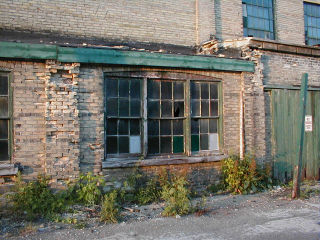 Crumbling brickwork |
The plastic pipes in the left image are a lot bigger than they look. They look like toys, but are actually the sort of pipes that kids crawl through in playground installations. The company made a lot of playground type furniture. Various fibreglass moylds for things like playground slides could be seen on the grounds. I'm guessing these pieces must have been rejects.
The shot on the right is of some of the crumbing buildings. Its the back part of the building shown on the first page of the site. The roof was leaking like crazy, and on parts of it the tar paper had been stripped by the wind entirely. Surprisingly, it looked like stuff was still being done in that part of the building when I took that photo.
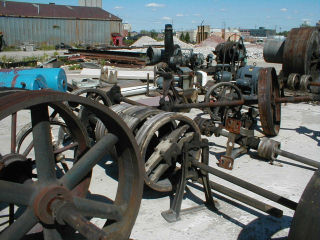 Lots of wooden flat belt pulleys |
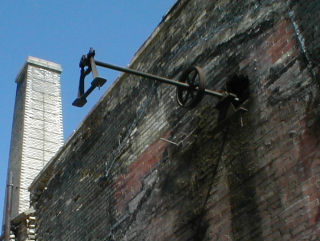 Drive shaft where the building was |
The factory was pretty old, with steam-era power distribution systems. I didn't actually see any steam engines, although I saw a couple of steam boilers coming out of the demolition. There certainly were plenty of shafts and pulleys. I like the shot on the right - part of a power transmission system still hanging in the air after the building around it was demolished.
 The back way I used to get in |
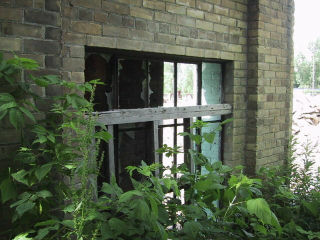 Idyllic looking smashed windows |
As the demolition progressed, the front entrance to the factory was gated off. Taking a good walk around I did however find a back entrance to the grounds that was not even locked. Through a small gate in a fence, and down some steps, and along a tree shaded pathway to the open grounds. The whole thing had a bit of a feeling of playing "Myst" to it. So quiet and mysterious, with the quiet hum of some transformers and the occasional clanking sound that came from one of the buildings. Sounded like some automated machinery slowly cycling through some operation.
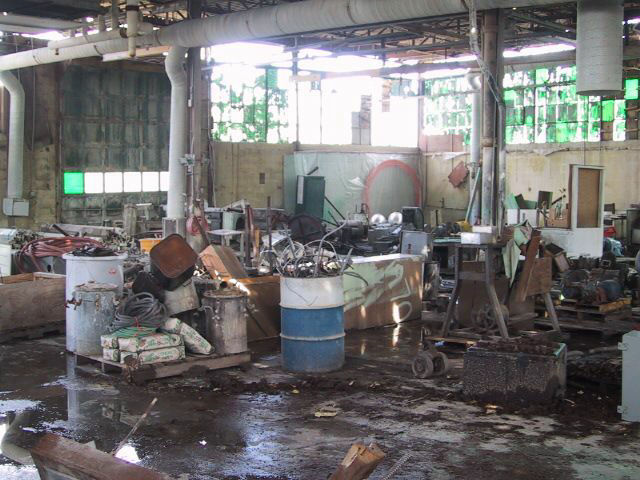 Inside the big factory hall |
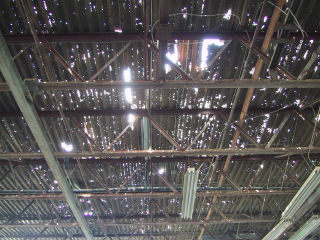 The roof had seen better days! |
The most interesting part was getting into the main factory hall. This was a large hall, with lots of old and rusty industrial equipment everywhere. There were lots of motors, some of them originally made for 25 hertz operation, and later rewound relabelled for 60 Hz operation. Also lots of equipment that had tons of hardened fibreglass goop dried onto it. There was nothing remotely new, except for a desk with some 80286 vintage computers on it. These somehow seemed out of place, somehow too modern looking, even though in terms of obsolescence relative to useful life, they were way older than the factory.
 Air compressor |
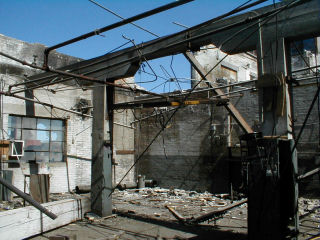 The pipes hanging in the air are the sprinkler system |
Most of the older buildings were in a more advanced stage of demolition. Less of a chance of something falling on my head there, I guess. With the small and dirty windows, I imagine these areas were dark and dingy originally. Very eerie, the whole area, with the high contrast form the sun shining directly in, and the disorganized mess of pipes. Very much a "ruins" feel to it!
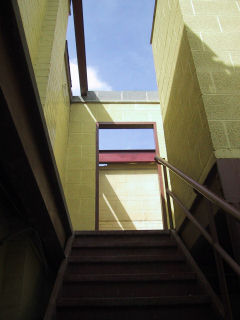 Funny walking around a building with no roof |
 A metal lathe, 1920's era. The electric motor was not part of the original lathe. Good lighting because the ceiling was already torn down. |
Much of the building already had its roof removed when I explored it. Just somehow seemed so strange. Abandoned buildings are inherently fascinating. More fascinating than buildings that are in use. Its the whole thing of what probably was, what might have been, imagining what it must have been like when it was in use. And in this building, in use was not that long ago. I saw scribbling on the wall NEW TANK INSTALLED 29/07/95 next to a shower stall. The hot water tank in question wasn't there anymore.
 Remains of some walls |
 Part of an older hall, mostly demolished |
More fascinating architecturally were some of the older parts of the building. This part had already been mostly cleared out. I could see though that all the floors and such in this part had been done with wooden timbers. Would have been interesting walking around these cavernous halls, with lots of timber posts and beams holding everything up.

View of the Canbar factory property as seen from the Seagram Lofts, June 2001
The whole factory was cleared to make way for townhouse condominiums of relatively high density. Last I'd read about it there was some argument between the city and Canbar as to how dense they'd be allowed to build the townhouses. By summer 2001, everything was cleared up. The concrete was all ground up to gravel, the steel all removed. Nothing much has happened with the property since. Still, an improvement over the factory that was there before. Other than satisfying my curiosity for a brief bit of time, it was mostly a smelly eyesore.
I also had taken some aerial photographs of my neighbourhood in the summer of 1998.
Seeing that the factory was close by, and of some curiosity to me, I also snapped a
picture of it then. The factory was then already partially demolished - only slightly
less than it was when I first snuck in with a digital camera the next year.
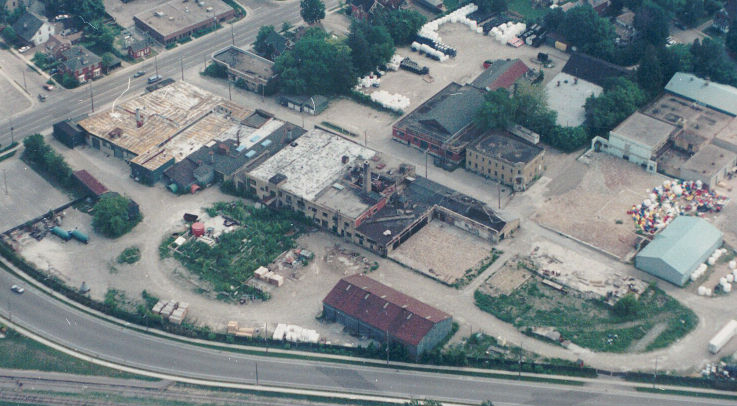
Aerial view of the Canbar factory, in 1998
Father David Bauer Blvd is at the bottom of the picture. It already cut off part of the grounds when it was constructed. On the top left is Erb street. The Canadian Barrels and Kegs building, as well as the Globe Furniture building can clearly be seen. The hall with the roof with the many holes in it is on the very left of the grounds.
See also Ontario Steam Heritage Museum
More old ruins
![]()